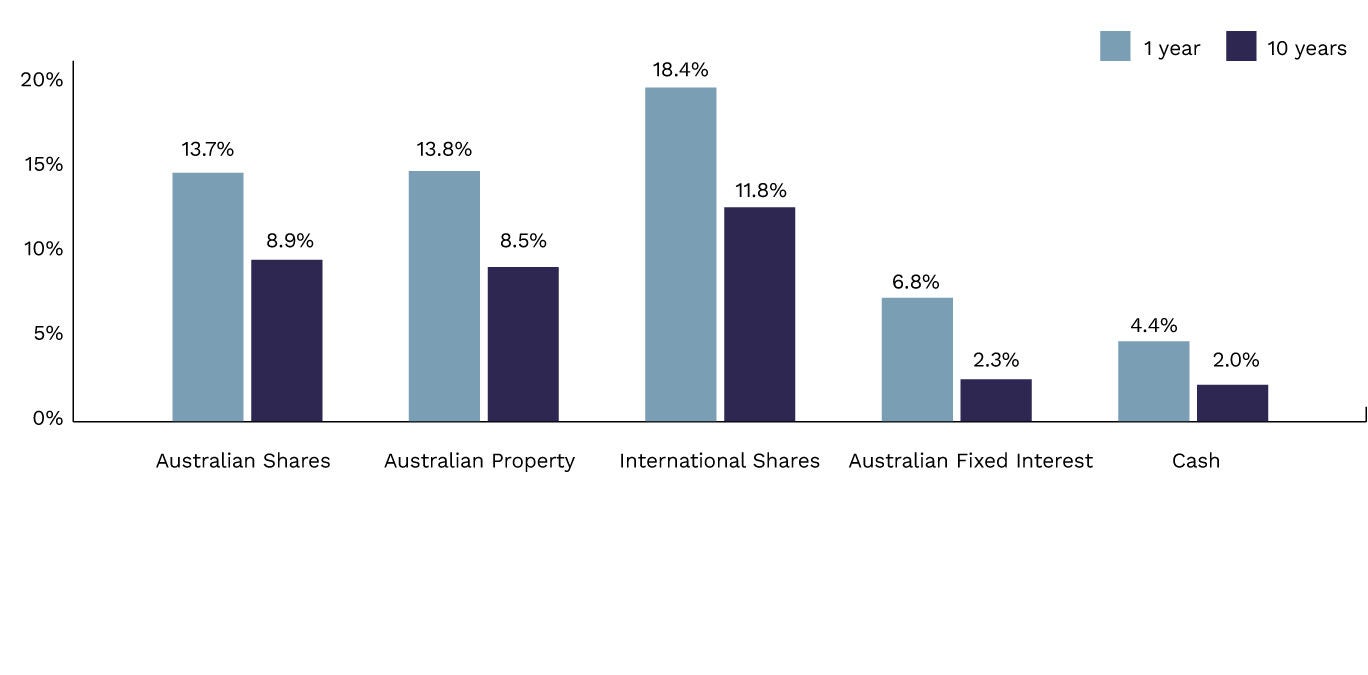We use cookies to improve your experience on our website. By continuing you acknowledge cookies are being used.
Investment market review - Quarter-ended 30 June 2025
- Title
- Investment market review - Quarter-ended 30 June 2025
The Research Team provides a performance summary and commentary on each of the five main asset classes.
Australian shares
Australian shares made an historic high in early June but ended the month with mild gains relative to the broader global sharemarkets. Over the quarter our domestic market proved more competitive, delivering 9.5% and outperforming global equities on an unhedged basis (6.1%).
The sharpest gains over the quarter was in the Information Technology sector with a 28.4% return largely due to a recovery in WiseTech. There were notable positive returns for the Financials (15.8%), Communication Services (14.3%) and Property Securities (13.7%) sectors which benefitted from the RBA cutting the cash interest rate by 0.25% to 3.85% in May.
Australian economic data provides a mixed backdrop. March GDP disappointed, coming in below expectations. The labour market remains robust and real after inflation wages are seeing growth; however, retail sales have been subdued. Most importantly, inflation continues to track towards target levels, helping support investors beliefs that the RBA will cut rates further in the coming months.
| 3-month return (%) | 1 year (% p.a.) | 10 year (% p.a.) |
|---|---|---|---|
| Australian shares | 9.5 | 13.7 | 8.9 |
Australian listed property trusts
The Australian Property sector rallied 13.8% in the June quarter with a strong bounce in Goodman group being joined by a rally in Charter Hall, Vicinity, Scentre Group and Mirvac.
The outlook for lower interest rates, an improved consumer outlook and the prospect of stability in underlying property valuations has helped.
| 3-month return (%) | 1 year (% p.a.) | 10 year (% p.a.) |
|---|---|---|---|
| Australian listed property trusts | 13.4 | 13.8 | 8.5 |
International shares
Global shares experienced a rollercoaster ride but ultimately posted a strong 6.1% return for the quarter, however currency fluctuations impacted Australian investors. For investors who held Global Shares hedged into Australian dollars, returns were an even stronger 9.5% over the quarter.
Currency had an influential impact for investors over the quarter and year. Unhedged returns lagged hedged returns over the quarter, however, the full year unhedged returns (18.4%) outperformed currency hedged return local currency or (13.5%) as the Australian dollar declined against the Japanese Yen (-12%), British Pound (-9%) and the Euro (-11%).
The US sharemarket benchmark S&P 500 Index ended the quarter at an historic high. Optimism on the potential of AI and solid profit growth by US technology companies continue to be the key drivers for US share gains. Investors are also confident that the US central bank will be cutting interest rates later this year despite the inflation risk from tariffs.
Asian share markets delivered impressive performances. Korea (21.6% return), Hong Kong (16.8%) and Taiwan (10.9%) posted very strong returns in their local currencies over the quarter. China delivered a mild 2.6% return, in local currency terms, given concerns over China’s growth prospects with US tariffs and a weak residential property market.
| 3-month return (%) | 1 year (% p.a.) | 10 year (% p.a.) |
|---|---|---|---|
International shares | 6.1 | 18.4 | 11.8 |
Fixed interest
Australian bonds provided a strong 6.8% annual return with the support of lower inflation and the Reserve Bank of Australia (RBA) cutting the cash interest rates by 0.5% to 3.85% in 2025 (0.25% in February and May).
Inflation has come down faster than initially expected at the beginning or 2025. The headline CPI declining to 2.1% p.a. in May and the trimmed mean inflation measure, the RBA preferred measure (and excludes the electricity rebates), decreased to 2.4%, slightly below the mid-point of the 2 – 3% target band. The economic backdrop remains supportive of a continues rate easing cycle, however, the RBA is monitoring the labour market resilience and stability of the current inflation levels closely.
Over the quarter the Australian 10-year bond yields were volatile, influenced by overseas sentiment and delays in RBA easing due to domestic labour market strength and international trade uncertainty. Despite the volatility, the 10 year yield ended June near its quarterly lows helping Australian bonds outperform global bonds.
At the end of June markets are pricing in expectations of a July rate cut and three further cuts from August onwards. This signals that markets are implying inflation, and unemployment will move to their respective “targets” by early 2026 (unemployment: 4.5% and core inflation at 2.5%).
| 3-month return (%) | 1 year (% p.a.) | 10 year (% p.a.) |
|---|---|---|---|
Fixed interest | 2.6 | 6.8 | 2.3 |
Cash
The RBA followed its interest rate reduction of February with a 0.25% reduction in May.
The move brought borrowing costs to their lowest in two years, as both headline and underlying inflation had eased into the RBA’s 2–3% target range. The board noted inflation risks are now more balanced, despite the labour market remaining relatively tight. The outlook remains uncertain, especially due to volatility in global trade policy. The RBA emphasized its readiness to respond decisively if global developments materially impact domestic activity or inflation.
| 3-month return (%) | 1 year (% p.a.) | 10 year (% p.a.) |
|---|---|---|---|
| Cash | 1.0 | 4.4 | 2.0 |
Historical one and ten year returns
The chart below compares one and ten year returns for the major asset classes, as at 30 June 2025.

